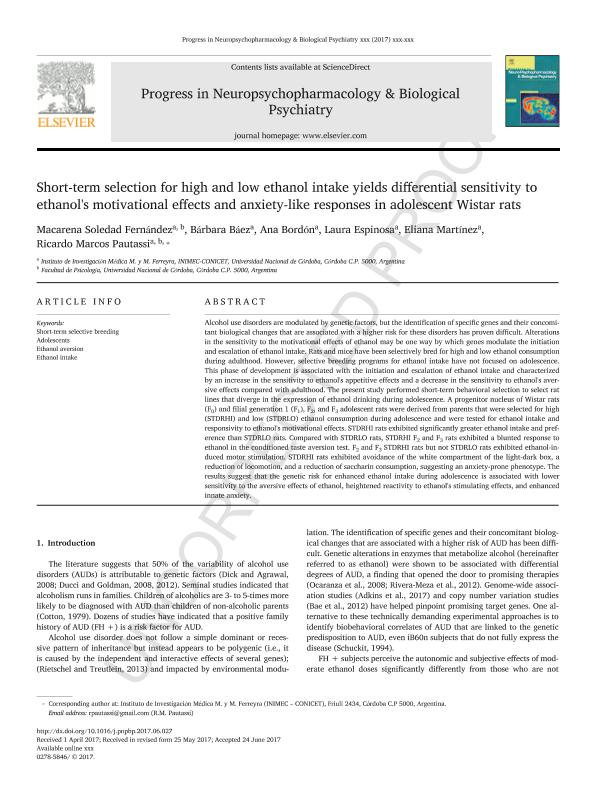Mostrar el registro sencillo del ítem
dc.contributor.author
Fernandez, Macarena Soledad

dc.contributor.author
Báez, Bárbara Beatriz

dc.contributor.author
Bordon, Ana
dc.contributor.author
Espinosa, Silvana Laura

dc.contributor.author
Martinez, Eliana Soledad

dc.contributor.author
Pautassi, Ricardo Marcos

dc.date.available
2018-11-06T19:25:40Z
dc.date.issued
2017-10-27
dc.identifier.citation
Fernandez, Macarena Soledad; Báez, Bárbara Beatriz; Bordon, Ana; Espinosa, Silvana Laura; Martinez, Eliana Soledad; et al.; Short-term selection for high and low ethanol intake yields differential sensitivity to ethanol's motivational effects and anxiety-like responses in adolescent Wistar rats; Pergamon-Elsevier Science Ltd; Progress of Neuro-psychopharmacology and Biological Psychiatry; 79; 27-10-2017; 220-233
dc.identifier.issn
0278-5846
dc.identifier.uri
http://hdl.handle.net/11336/63810
dc.description.abstract
Alcohol use disorders are modulated by genetic factors, but the identification of specific genes and their concomitant biological changes that are associated with a higher risk for these disorders has proven difficult. Alterations in the sensitivity to the motivational effects of ethanol may be one way by which genes modulate the initiation and escalation of ethanol intake. Rats and mice have been selectively bred for high and low ethanol consumption during adulthood. However, selective breeding programs for ethanol intake have not focused on adolescence. This phase of development is associated with the initiation and escalation of ethanol intake and characterized by an increase in the sensitivity to ethanol's appetitive effects and a decrease in the sensitivity to ethanol's aversive effects compared with adulthood. The present study performed short-term behavioral selection to select rat lines that diverge in the expression of ethanol drinking during adolescence. A progenitor nucleus of Wistar rats (F0) and filial generation 1 (F1), F2, and F3 adolescent rats were derived from parents that were selected for high (STDRHI) and low (STDRLO) ethanol consumption during adolescence and were tested for ethanol intake and responsivity to ethanol's motivational effects. STDRHI rats exhibited significantly greater ethanol intake and preference than STDRLO rats. Compared with STDRLO rats, STDRHI F2 and F3 rats exhibited a blunted response to ethanol in the conditioned taste aversion test. F2 and F3 STDRHI rats but not STDRLO rats exhibited ethanol-induced motor stimulation. STDRHI rats exhibited avoidance of the white compartment of the light-dark box, a reduction of locomotion, and a reduction of saccharin consumption, suggesting an anxiety-prone phenotype. The results suggest that the genetic risk for enhanced ethanol intake during adolescence is associated with lower sensitivity to the aversive effects of ethanol, heightened reactivity to ethanol's stimulating effects, and enhanced innate anxiety.
dc.format
application/pdf
dc.language.iso
eng
dc.publisher
Pergamon-Elsevier Science Ltd

dc.rights
info:eu-repo/semantics/openAccess
dc.rights.uri
https://creativecommons.org/licenses/by-nc-sa/2.5/ar/
dc.subject
Adolescents
dc.subject
Ethanol Aversion
dc.subject
Ethanol Intake
dc.subject
Short-Term Selective Breeding
dc.subject.classification
Psicología

dc.subject.classification
Psicología

dc.subject.classification
CIENCIAS SOCIALES

dc.title
Short-term selection for high and low ethanol intake yields differential sensitivity to ethanol's motivational effects and anxiety-like responses in adolescent Wistar rats
dc.type
info:eu-repo/semantics/article
dc.type
info:ar-repo/semantics/artículo
dc.type
info:eu-repo/semantics/publishedVersion
dc.date.updated
2018-10-22T15:53:01Z
dc.journal.volume
79
dc.journal.pagination
220-233
dc.journal.pais
Países Bajos

dc.journal.ciudad
Amsterdam
dc.description.fil
Fil: Fernandez, Macarena Soledad. Consejo Nacional de Investigaciones Científicas y Técnicas. Centro Científico Tecnológico Conicet - Córdoba. Instituto de Investigación Médica Mercedes y Martín Ferreyra. Universidad Nacional de Córdoba. Instituto de Investigación Médica Mercedes y Martín Ferreyra; Argentina. Universidad Nacional de Córdoba. Facultad de Psicología; Argentina
dc.description.fil
Fil: Báez, Bárbara Beatriz. Consejo Nacional de Investigaciones Científicas y Técnicas. Centro Científico Tecnológico Conicet - Córdoba. Instituto de Investigación Médica Mercedes y Martín Ferreyra. Universidad Nacional de Córdoba. Instituto de Investigación Médica Mercedes y Martín Ferreyra; Argentina
dc.description.fil
Fil: Bordon, Ana. Consejo Nacional de Investigaciones Científicas y Técnicas. Centro Científico Tecnológico Conicet - Córdoba. Instituto de Investigación Médica Mercedes y Martín Ferreyra. Universidad Nacional de Córdoba. Instituto de Investigación Médica Mercedes y Martín Ferreyra; Argentina
dc.description.fil
Fil: Espinosa, Silvana Laura. Consejo Nacional de Investigaciones Científicas y Técnicas. Centro Científico Tecnológico Conicet - Córdoba. Instituto de Investigación Médica Mercedes y Martín Ferreyra. Universidad Nacional de Córdoba. Instituto de Investigación Médica Mercedes y Martín Ferreyra; Argentina
dc.description.fil
Fil: Martinez, Eliana Soledad. Consejo Nacional de Investigaciones Científicas y Técnicas. Centro Científico Tecnológico Conicet - Córdoba. Instituto de Investigación Médica Mercedes y Martín Ferreyra. Universidad Nacional de Córdoba. Instituto de Investigación Médica Mercedes y Martín Ferreyra; Argentina
dc.description.fil
Fil: Pautassi, Ricardo Marcos. Consejo Nacional de Investigaciones Científicas y Técnicas. Centro Científico Tecnológico Conicet - Córdoba. Instituto de Investigación Médica Mercedes y Martín Ferreyra. Universidad Nacional de Córdoba. Instituto de Investigación Médica Mercedes y Martín Ferreyra; Argentina. Universidad Nacional de Córdoba. Facultad de Psicología; Argentina
dc.journal.title
Progress of Neuro-psychopharmacology and Biological Psychiatry

dc.relation.alternativeid
info:eu-repo/semantics/altIdentifier/doi/https://dx.doi.org/10.1016/j.pnpbp.2017.06.027
dc.relation.alternativeid
info:eu-repo/semantics/altIdentifier/url/https://www.sciencedirect.com/science/article/pii/S027858461730252X
Archivos asociados
